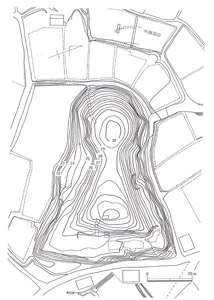本文
Tsukiyama kofun (burial mound)
Tsukiyama kofun (burial mound)

Prefecturally Designated Important Cultural Property (designated 1959)
Made: Late 5th c. CE
Location: Nishisue, Osafune
Dimensions: 82m long (approx.)
One of Setouchi city’s most important keyhole-shaped burial mounds, it is believed to have been built in the latter half of the 5th century. This kofun is surrounded by a double moat, and originally featured rings of cylindrical clay figures around the base, terrace, and top of the kofun. It seems that the surface of this kofun was once shingled with 15cm breccia stones. The pit-style stone burial chamber in the circular rear section of the mound now lies exposed, the house-shaped sarcophagus, carved out of a single stone, visible inside. It has been ascertained that the tuff used to construct the coffin was mined in the south of Japan near Uto City, Kumamoto Prefecture, Kyūshū and was originally formed in the aftermath of an eruption from Mt. Aso.
The 1907 excavation at the site unearthed many artefacts from the mound, among which were a mirror, three iron swords (one single-edged and two double-edged), a glass magatama (comma-shaped bead), and a number of stone beads. These finds are now stored in the collections of the Tokyo National Museum.





